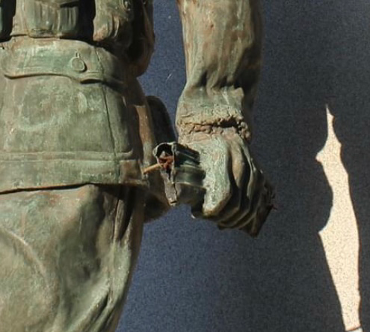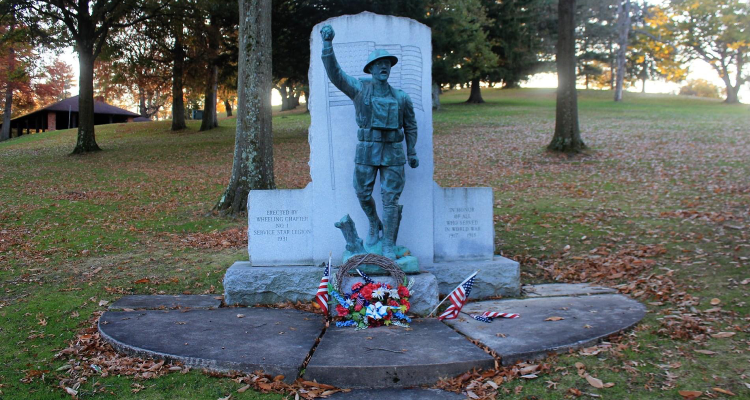For nearly 90 years a silent guardian has kept watch over Wheeling Park. Originally dedicated on Memorial Day of 1931, Wheeling’s Doughboy statue has withstood weathering and vandalism to remain an enduring monument to the men — and, frankly, boys — of the Friendly City who answered their country’s call in 1917.
WHAT IS A DOUGHBOY?
To start, what exactly is a Doughboy? The term was used in the early 20th century to denote American infantryman, essentially a prior version of the more widely known “G.I.” monicker. The origin of the name is not definitively known, though a popular theory stems from Salvation Army volunteers making large amounts of doughnuts for the American troops arriving in France, while others note that the name actually dates back to the Mexican-American War in the 1840s.
Regardless of the source of their nickname, over 4 million Americans served in the U.S. military during World War I. Wheeling’s Doughboy was one of hundreds of statues, officially called Spirit of the American Doughboy, that were erected in cities across the country in the 1920s and ’30s to recognize the sacrifice and heroism of those veterans. At that time, World War I was still seen as the “War to End All Wars” and the Spirit of the American Doughboy statues were as much a testament of their contribution to peace as it was a monument to their service in wartime.

It is important to denote the difference between a monument, which the Wheeling Doughboy is, in contrast to a memorial. In common parlance, they are often used interchangeably, but there are key distinctions. A monument is typically an architectural feature or — in the case of our Doughboy — a piece of public art that is intended to commemorate a person, group or event; our statue was dedicated to honor the men of Wheeling who served in World War I.
A memorial, on the other hand, is created to preserve the memory of a person or place. Consider for instance, the Vietnam War Memorial in Washington D.C., which explicitly enshrines in memory the 58,320 names etched onto its walls. The tones of monuments and memorials often differ, with memorials leaning toward solemnity, and monuments exhibiting a triumphant flair.

Until the construction of the Veteran’s Amphitheater along the downtown riverfront in the 1990s, the Doughboy statue was one of the city’s most significant public monuments to its veterans.
“It started out as a monument to the men who fought in World War I, but over time it came to represent people who served in the military during all eras,” said Margaret Brennan, a member of the Wheeling Doughboy Restoration Committee and Wheeling historian.
Perhaps part of this could be because of the statue’s central position in Wheeling’s Memorial Day events for much of the 20th century. First dedicated on Memorial Day of 1931, the site continued to be the location of successive commemorations. Along with its then-neighboring Soldiers’ and Sailors’ Monument (built to honor Union veterans from the Civil War), the Wheeling Doughboy monument was a fixture of such events from the 1940s-on.
SIGNS OF AGE
In later decades, the Doughboy began to show the signs of its age. The statue’s rifle had been stolen in the 1940s by a group of pranksters, and the barbed wire was broken off the base. Nearly 90 years of rain, snow and ice had also taken their toll, tarnishing the original luster of the monument. The 100th anniversary of Armistice Day on Nov. 11, 2018 brought the deteriorating condition of the Doughboy front and center, and a committee was formed to restore the monument to its former glory.
The Wheeling Doughboy Restoration Committee quickly went to work identifying a restoration expert for the statue, which they found in Giorgio Gikas, a Detroit-based bronze sculptor who specializes in the conservation of outdoor statues. Gikas and his team removed the statue in November of 2019 and transported it to Detroit, where it is currently undergoing restoration.

Initially, the statue was expected to be ready for a rededication ceremony this weekend, keeping with its Memorial Day origins. But because of COVID-19 and related shutdowns in Michigan, the Doughboy will likely not return to Wheeling until this summer. According to committee member Sean Duffy, they hope to reinstall the statue by late June, with a formal rededication planned for Veterans’ Day.
While the statue itself is being restored in Detroit, work continues in Wheeling as well. According to Brennan, the pedestal and surrounding area are being redone by Savage Construction, which will enhance the entire monument.

COMMUNITY INVOLVEMENT
Of course, the restoration and landscaping that Wheeling’s Doughboy deserves comes at a price. Fortunately, the Friendly City has stepped up to make it all possible.
The Restoration Committee began soliciting funds for the project in late 2019, which so far has been met with significant local support. A very cleverly named “Dough Fund Me” page on the GoFundMe crowdfunding website has raised over $1,200 so far, while checks have been received in care of the Community Foundation for the Ohio Valley. The campaign is still accepting donations, which in addition to the Dough Fund Me page can be made by check to the CFOV. Prospective donors can address the check to the Community Foundation for the Ohio Valley, 1226 Chapline St. Wheeling, WV 26003. Be sure to indicate “Doughboy Monument Restoration Fund” in the memo line.
A PERSONAL CONNECTION
Many of the donors to the restoration work have a personal connection either to the Doughboy Statue or World War I. Both are certainly the case for Joe Gompers of Wheeling, who was at both the 100th commemoration of Armistice Day in 2018, and most notably at the dedication of the statue in 1931. Gompers — who was 7 years old at the time — attended with his family as his father, William, was one of the main speakers. William Gompers served in the 313th Field Artillery during World War I, and later became a leader in Wheeling’s Post 1 of the American Legion.

“I have vivid memories of the people coming in off the trolley cars, there were hoards of people there that day,” said Gompers. “I pushed my way up to the front where they had a stage; to the left of the stage was a band, and to the left of that was a large refreshment stand. I don’t remember anything that was said, but I remember all of the goodies on that stand.”
Gompers followed his father’s footsteps in serving his country, spending an impeccably precise amount of time: three years, eight months, 20 days and 10 hours in the U.S. Navy during World War II. A member of the Greatest Generation, he is still just as proud of the contributions made by men like his father in the preceding conflict. To him, Wheeling’s Doughboy is a testament to them, and deserves to be preserved for future generations.
Over the past 89 years, Wheeling’s Doughboy has come to represent different things for different members of our community. What we share, however, is the solemn respect we have for our city’s veterans. Since the American Revolution, Wheelingites have served in every major American conflict.
This summer the Wheeling Doughboy will return to Wheeling, but many of our real-life Doughboys did not come home in 1919. This weekend we remember their sacrifice, and the sacrifice of the scores of soldiers, sailors, marines and airmen who gave their last full measure of devotion.
• Nick Musgrave is a self-described history geek living in Wheeling, West Virginia. He is a graduate of Hastings College in Hastings, Nebraska, where he earned his bachelor’s degrees in history and political science. When not writing for Weelunk or uncovering cool stories about the past, he can often be found reading in his hammock or trying to brew the perfect cup of coffee.


